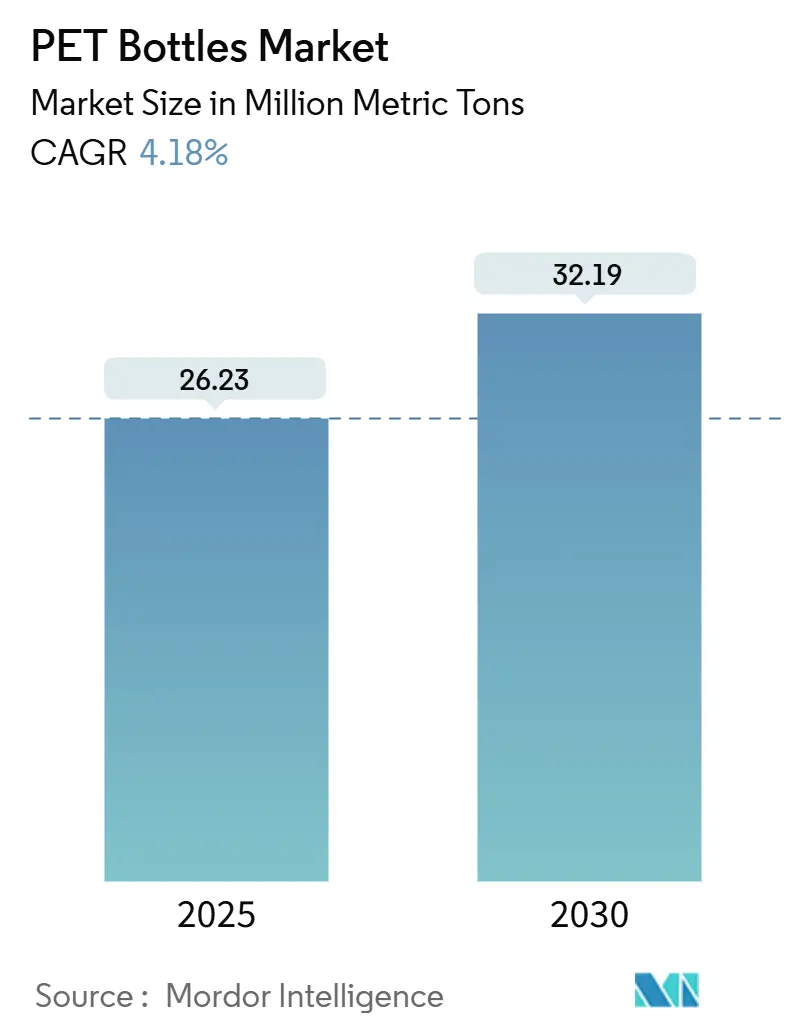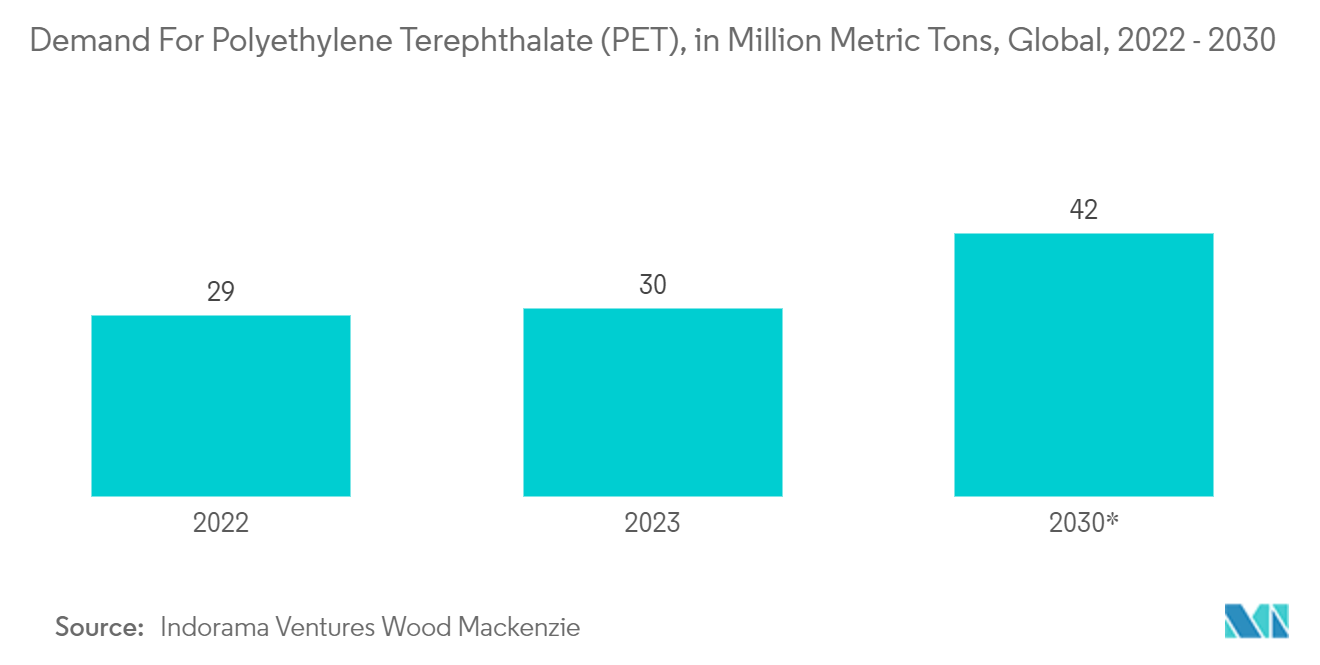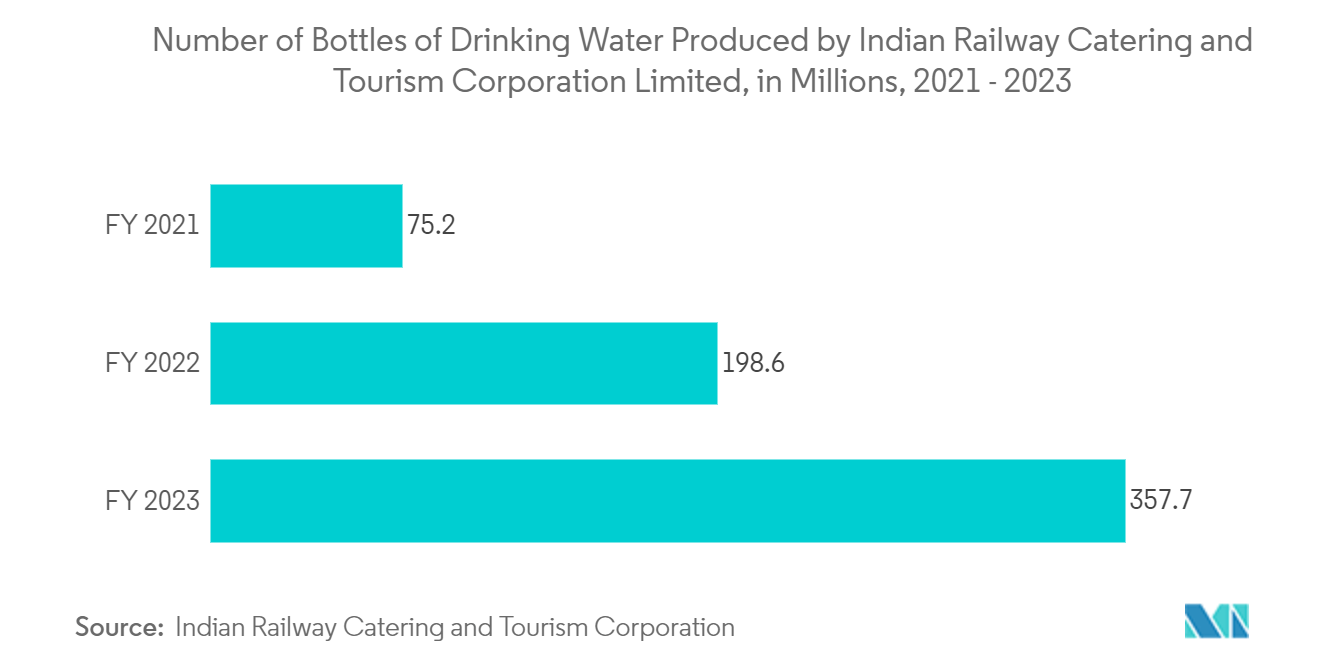
PET Bottles Market Analysis
The PET Bottles Market size is estimated at 26.23 Million metric tons in 2025, and is expected to reach 32.19 Million metric tons by 2030, at a CAGR of 4.18% during the forecast period (2025-2030).
- Plastic bottles and containers, primarily made of polyethylene terephthalate, are widely used because they are lightweight and durable, facilitating easier handling. Manufacturers prefer plastic packaging because of its lower production costs. During the forecast period, the market studied is poised for growth, propelled by the cost-effectiveness of plastic packaging and the rising demand for packaged food and beverages.
- Furthermore, polyethylene terephthalate (PET) containers are favored for their durability, versatility, and cost-effectiveness. As end-user industries such as food, beverage, and pharmacy expand and innovate, the demand for plastic bottles and container packaging grows. The introduction of new drinks with various flavors and packaging formats in the industry continues to drive the need for rigid plastic bottles.
- PET bottles are increasingly replacing glass bottles due to their lightweight and durable nature. These bottles can be used to pack mineral water and other beverages, enabling more cost-effective transportation. PET's transparency and inherent CO2 barrier properties suit it for various applications. PET can readily be molded into different shapes or blown into bottles. Manufacturers can customize PET's properties by incorporating additives like colorants, UV blockers, and oxygen barriers, enabling the creation of bottles tailored to specific brand needs.
- The PET packaging market faces significant challenges due to evolving regulatory standards, primarily driven by growing environmental concerns. Governments worldwide are responding to public apprehension about plastic packaging waste by implementing regulations to minimize environmental impact and improve waste management processes.
- These regulatory changes often include restrictions on single-use plastics, increased recycling targets, and extended producer responsibility programs. As a result, PET packaging manufacturers adapt their production processes, invest in eco-friendly alternatives, and develop more sustainable packaging solutions to comply with these new standards. This regulatory landscape affects the industry's operational costs and influences consumer preferences as environmentally conscious consumers increasingly demand sustainable packaging options.
- Sustainable packaging solutions have gained prominence due to increased consumer awareness regarding the environmental benefits of eco-friendly packaging. PET has become an essential resin among eco-friendly packaging materials due to its recyclability and potential for circularity. Closed-loop recycling, where plastic is recycled and used to create new products in the same category, is often applied to PET bottles. This approach has led businesses to prioritize PET over other resin materials. As a result, the recycling of plastic bottles is expected to impact the market positively.
- Companies are innovating to meet the increasing demand for rPET across end-user segments. The surge in sustainable packaging is propelled by consumer preferences and regulatory mandates to curb plastic waste.
- For instance, in June 2024, Kraft Heinz introduced 100% recycled PET bottles for its 12- and 22-oz Kraft Real Mayo and Miracle Whip sizes. This move followed the company's 2023 announcement of a goal to reduce virgin plastic use in its global packaging portfolio by 20% by 2030. Adopting rPET in food packaging demonstrates the material's versatility and growing acceptance in the industry. Other companies are likely to follow suit, potentially leading to a significant increase in rPET demand and further innovations in recycling technologies to meet this demand.
PET Bottles Market Trends
The Beverages Segment is Expected to Witness Significant Growth
- PET bottles dominate the water packaging industry over glass and other plastic bottles due to their durability and recyclability. The trend indicates that lightweight, durable, and cost-effective PET is increasingly becoming the preferred packaging medium for water. This shift is driven by consumer demand for convenience and sustainability and manufacturers' need for efficient and cost-effective packaging solutions. Due to their moldability, PET bottles can quickly adapt to changing packaging trends and labeling needs, providing a versatile canvas for design and branding. Their lightweight and durable properties make them a preferred choice for bottled beverages and contribute to cost-effective transportation and lower carbon emissions.
- Polyethylene terephthalate (PET) bottles are increasingly prevalent across diverse product segments. Their appeal lies in their affordability, lightweight nature, and the continuous advancements in printing technologies. These factors have notably elevated PET bottles' status, particularly among discerning consumers. Indorama Ventures projects a surge in demand for polyethylene terephthalate resins, from 30 million metric tons in 2023 to 42 million by 2030.
- The beverages segment in the PET bottles market is poised for growth due to increasing demand for bottled water and non-alcoholic beverages. This demand is driven by consumers' preference for high-quality drinking water, concerns about contaminated tap water, and the convenience of portable bottled water. The global demand for packaged drinking water may further propel the beverage category in the plastic bottle packaging industry. Plastic bottles are favored for their cost-effectiveness, extended shelf life, and ease of use compared to other packaging options.
- Governments worldwide are intensifying their efforts to promote recycling single-use plastic bottles. Strategies include encouraging consumers to refill reusable plastic bottles, utilizing biodegradable or recycled PET for manufacturing, designing eco-friendly products, and establishing dedicated councils for bottle recycling. Manufacturers are responding to this trend by innovating. They strive to meet government regulations and corporate sustainability goals and are positioning themselves as leaders in sustainable production.

Asia-Pacific Expected to Hold Significant Share in the Market
- The beverage packaging industry in the region has experienced significant growth in recent years. Key factors driving this growth include rapid changes in packaging trends across the region. New trends in beverage packaging focus on structural changes, the development of recycled materials such as post-consumer recycling, customer acceptance, safety, newer filling technologies, and the development of heat-resistant PET bottles. These advancements have provided new possibilities and options in the market while improving the preservation of various drinks.
- The consumption of bottled water is increasing across China and India due to population growth and changing lifestyles. This trend is creating demand for various bottle formats that are lightweight, portable, and easily stored while meeting sustainability regulations. With its large population and developing economy, India is experiencing a significant increase in bottled water consumption. The Indian Railway Catering and Tourism Corporation Limited introduced a PET bottled water brand, "Rail Neer," primarily sold on trains and at railway stations. The corporation is increasing production with the increase in bottled water consumption and expansion of the railway industry. In 2021, 75.30 million bottles were produced, which rose to 357.70 million in 2023.
- Countries in the region are shifting their focus toward sustainable and eco-friendly practices to promote the use of recycled plastic. This shift has prompted beverage manufacturers like Coca-Cola to incorporate recycled plastic into their strategies for reducing environmental impact. In April 2024, The Coca-Cola Company, a US-based beverage company, introduced Coca-Cola Original, Coca-Cola No Sugar, and Coca-Cola Plus bottles made from recycled polyethylene terephthalate (rPET) in Hong Kong. In Beijing, INCOM announced the commencement of phase II of its rPET plant in Tianjin in June 2023. The project aims to establish a food-grade packaging production line with an annual waste plastic bottle processing capacity of 50,000 tons.
- Furthermore, in June 2023, Coca-Cola India, in partnership with Austrian packaging solution provider ALPLA, introduced a groundbreaking initiative for its Kinley brand in India. Kinley, a prominent bottled drinking water brand, now exclusively utilizes 100% recycled rPET bottles, marking a pioneering move in India's beverage landscape. Notably, these bottles, available in one-liter variants, are the nation's inaugural offering in the food and beverage realm crafted from such sustainable materials. This strategic collaboration underscores ALPLA's and Coca-Cola's commitment to fostering a circular economy.
- Southeast Asian countries, including Indonesia, Cambodia, Singapore, Thailand, and Vietnam, experienced increased demand for PET bottles in various industries. This growth is particularly notable in the food and beverage industry, where PET bottles are widely used for packaging beverages and liquid food products. In the pharmaceutical industry, PET bottles are preferred for their durability and resistance to chemical interactions. The cosmetics and personal care industries also contribute to this demand, utilizing PET bottles for products such as shampoos, lotions, and other personal care items. This widespread adoption across multiple sectors has been a significant factor in driving market growth in Asia-Pacific.
PET Bottles Industry Overview
The PET bottles market is fragmented, with several global and regional players, such as Amcor Group GmbH, Gerresheimer AG, Alpla Group, and Berry Global Inc., vying for attention in a contested market space. This market is characterized by low product differentiation, growing levels of product penetration, and high levels of competition.
- May 2024 - ALPLA introduced a recyclable PET wine bottle that offers several advantages over traditional glass bottles. This innovative packaging solution weighs approximately one-eighth of a glass bottle, reduces carbon footprint by up to 50%, and can lower costs by up to 30%. The bottle is manufactured entirely from recycled PET (rPET).
- April 2024 - Amcor, a player in developing and producing responsible packaging solutions, announced the launch of a 1 L polyethylene terephthalate (PET) bottle for carbonated soft drinks (CSDs) made entirely from post-consumer recycled (PCR) content. Amcor Rigid Packaging (ARP) is expected to incorporate this 1 L CSD 100% PCR bottle into its growing portfolio of responsible packaging made from recycled materials.
PET Bottles Market Leaders
-
Gerresheimer AG
-
Alpla Group
-
Berry Global Inc.
-
SILGAN PLASTICS LLC (Silgan Holdings Inc.)
-
Amcor Group GmbH
- *Disclaimer: Major Players sorted in no particular order
PET Bottles Market News
- June 2024: Coca-Cola India, having pioneered using 100% recycled PET (rPET) in the Indian beverage industry, is advancing its circular economy initiatives. The company introduced Coca-Cola in 250 ml bottles made from 100% recycled PET (rPET) using advanced sustainability packaging solutions (ASSP). This product, manufactured by Coca-Cola's bottling partner Hindustan Coca-Cola Beverages Pvt. Ltd (HCCBPL), demonstrates the company's commitment to sustainability, focusing on reducing carbon footprint and enhancing environmental responsibility.
- March 2024: The Coca-Cola Company implemented a comprehensive light-weighting initiative for its small PET bottles, reducing their weight and, in many instances, altering their shape. By 2024, all small PET bottles in the 12 oz, 16.9 oz, and 20 oz sizes are projected to be lightweight from 21 g to 18.5 g. This change applies to all of The Coca-Cola Company's sparkling brands, Minute Maid refreshments, and Minute Maid Aguas Frescas in the United States and Canada.
PET Bottles Indusrry Segmentation
Polyethylene terephthalate (PET) is used in plastic bottle production. Its popularity stems from its durability, cost-effectiveness, and high recyclability, making it practical and environmentally responsible. PET bottles are characterized by their transparency, lightweight nature, and flexibility. They effectively preserve the quality of their contents, maintaining taste and odor. After use, PET bottles can be easily recycled through dedicated collection systems. The beverage industry widely adopts PET because it can withstand various temperatures and pressures, ensuring product safety and quality. The material's lightweight nature reduces transportation costs and energy consumption, enhancing its environmental benefits. PET's recyclability contributes to a circular economy model, promoting material reuse, waste reduction, and resource conservation.
The PET bottles market is segmented by end-user vertical (beverages [packaged water, carbonated soft drinks, fruit juice, energy drinks, and other beverages], food, personal care, household care, pharmaceuticals, and other end-user verticals) and geography (North America [United States and Canada], Europe [United Kingdom, Germany, France, Italy, and Rest of Europe], Asia [China, India, Japan, Australia and New Zealand, and Rest of Asia], Latin America [Mexico, Brazil, Columbia, and Rest of Latin America], and Middle East and Africa [Saudi Arabia, South Africa, United Arab Emirates, and Rest of Middle East and Africa]). The market sizes and forecasts are provided in terms of volume (tonnes) for all the above segments.
| By End-user Vertical | Beverages | Packaged Water | |
| Carbonated Soft Drinks | |||
| Fruit Juice | |||
| Energy Drinks | |||
| Other Beverages | |||
| Food | |||
| Personal Care | |||
| Household Care | |||
| Pharmaceuticals | |||
| Other End-user Verticals | |||
| By Geography*** | North America | United States | |
| Canada | |||
| Europe | United Kingdom | ||
| Germany | |||
| France | |||
| Italy | |||
| Asia | China | ||
| India | |||
| Japan | |||
| Australia and New Zealand | |||
| Latin America | Mexico | ||
| Brazil | |||
| Middle East and Africa | Saudi Arabia | ||
| South Africa | |||
| United Arab Emirates | |||
PET Bottles Market Research Faqs
How big is the PET Bottles Market?
The PET Bottles Market size is expected to reach 26.23 million metric tons in 2025 and grow at a CAGR of 4.18% to reach 32.19 million metric tons by 2030.
What is the current PET Bottles Market size?
In 2025, the PET Bottles Market size is expected to reach 26.23 million metric tons.
Who are the key players in PET Bottles Market?
Gerresheimer AG, Alpla Group, Berry Global Inc., SILGAN PLASTICS LLC (Silgan Holdings Inc.) and Amcor Group GmbH are the major companies operating in the PET Bottles Market.
Which is the fastest growing region in PET Bottles Market?
Asia Pacific is estimated to grow at the highest CAGR over the forecast period (2025-2030).
Which region has the biggest share in PET Bottles Market?
In 2025, the Asia Pacific accounts for the largest market share in PET Bottles Market.
What years does this PET Bottles Market cover, and what was the market size in 2024?
In 2024, the PET Bottles Market size was estimated at 25.13 million metric tons. The report covers the PET Bottles Market historical market size for years: 2019, 2020, 2021, 2022, 2023 and 2024. The report also forecasts the PET Bottles Market size for years: 2025, 2026, 2027, 2028, 2029 and 2030.
Our Best Selling Reports
PET Bottles Industry Report
Statistics for the 2025 PET Bottles market share, size and revenue growth rate, created by Mordor Intelligence™ Industry Reports. PET Bottles analysis includes a market forecast outlook for 2025 to 2030 and historical overview. Get a sample of this industry analysis as a free report PDF download.

.webp)

.webp)

